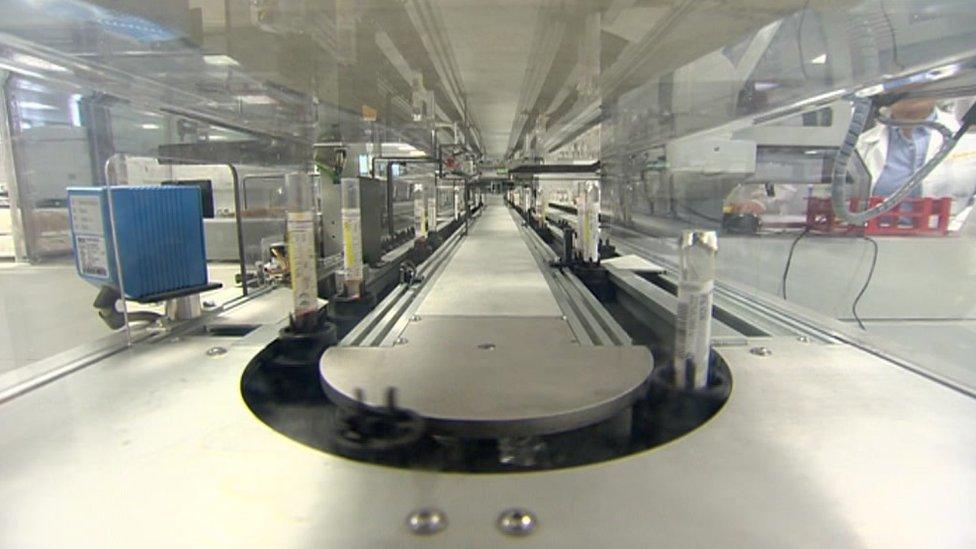A faster test for antibiotic resistance is on its way
- Published

Blood samples whizz round the automated track in the lab at Heartlands Hospital
I'm standing next to what looks like a highly automated production line.
There are conveyor belts and fast moving robots, but this isn't a car factory.
Instead this is the modern face of blood testing.
Tiny phials of blood are whizzing around the room being tested by a variety of automated machines.
All around people in lab coats are bustling to keep everything running smoothly.
Thousands of blood and urine samples whizz though facilities like this in many of our major hospitals.

The new prototype testing machine can produce a result in about a minute
It is an extremely efficient service; nevertheless from a GP taking a sample to getting a result can still take a couple of days.
Now a new invention from scientists at the University of Birmingham aims to move some of that testing out of the lab and into your GP's surgery or High Street chemist and to cut that testing time from days to just a minute.
Although this new test can be retooled to look for many different things, the team from Birmingham are focusing their initial efforts on to urinary tract infections (UTIs).
This will create a simple test that can detect infection in a patient's urine and also further check to see if the infection is resistant to common antibiotics.
Antibiotic resistance
Currently if you go to your doctor with a UTI, he or she will send a sample off to the local lab for testing and, in the meantime, start you on a course of antibiotics.
Of course when the result comes back in a couple of days it may show that particular infection is resistant to the antibiotic the doctor gave you.
That means you need to start over with a different antibiotic and it will take longer to clear things up.
But there's a bigger problem.
Although the initial medicine won't have had any impact on your infection, the antibiotic it contains could come into contact with other bugs in your body and they may go on to develop a resistance to it, fuelling the more general problem of antibiotic resistance.
But with this test you can avoid all this and instead discover in a minute if you are infected and which antibiotics will work against the infection.
Big clumps
So how does it work?
Well, long straight molecules called bacteriophage M13, external are mixed with the urine sample from the patient.
Usually they sit in nice straight lines like dried spaghetti in a packet.
But they are designed to "lock on" to any infection and, when they do, they go from nice straight lines to big clumps.
This change is detected and that gives the result.
This research started at the University of Birmingham and has now been spun-out into a new company called Linear Diagnostics, external based on campus at the Biohub, external.
You can read more about the research here, external.
Excitingly, you can tweak the molecules so they lock on to all sorts.
Other diseases
In this new test that means they can detect infection and also antibiotic resistance.
But the hope is this simple idea could be expanded to test for many other diseases.
For now though the focus is on UTIs and clinical trials start in hospitals soon, with the aim of having a test on the market by the end of the year.
It means patients should get better, more targeted treatment, clearing up the infection faster.
But it's also a useful new tool in a the bigger battle against the growing problem of antibiotic resistance.